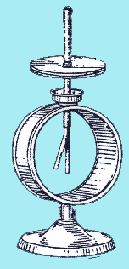The completely ionized helium atom He++, missing both electrons, is also known as the "alpha particle" (see history section). Just as in the Sun and in most stars, hydrogen is the most abundant element with helium next, so the solar wind consist mostly of protons, with 5% alpha particles and small numbers of heavier ions.
A somewhat similar composition exists among cosmic rays, a very thin drizzle of ions moving close to the speed of light and bombarding the Earth from all directions; they probably fill our galaxy and their origin is uncertain.
It may be mentioned that in addition to such atomic ions, there also exist molecular ions of either sign, formed when intact molecules lose or gain an electron. Such ions occur in ionospheric processes.
Clouds of barium ions
An atom can become ionized by the absorption of light. The atom of barium is particularly easy to ionize, because its outermost electron is very loosely bound. If a mass of barium is vaporized in space, producing a barium cloud, much of the barium becomes ionized by sunlight within less than a minute. The cloud then moves in response to electric forces in space, and can be used to study the electrical field in space.
In practice the barium is packed into canisters with copper oxide, and these are released from rockets or satellites and ignited. The resulting chemical reaction produces great heat, but more barium is packed into the canister than can combine chemically, and some the excess is vaporized to form a large
spherical greenish cloud.




 Official GSFC Home Page
Official GSFC Home Page  NASA WWW Home Page
NASA WWW Home Page